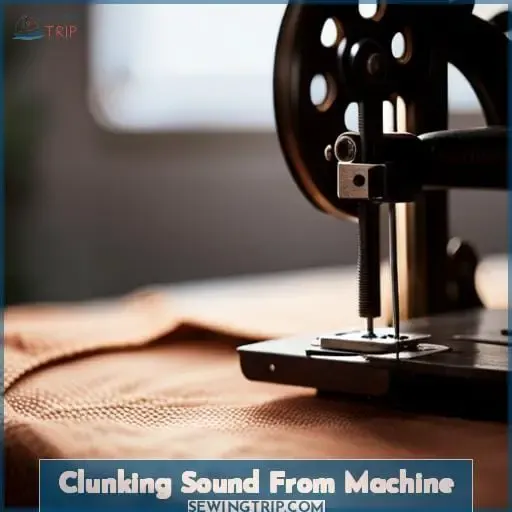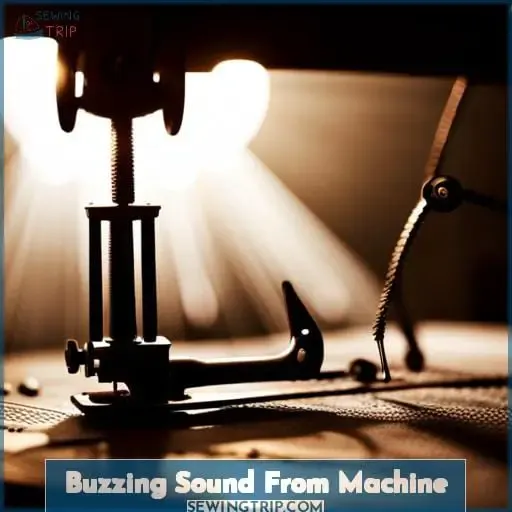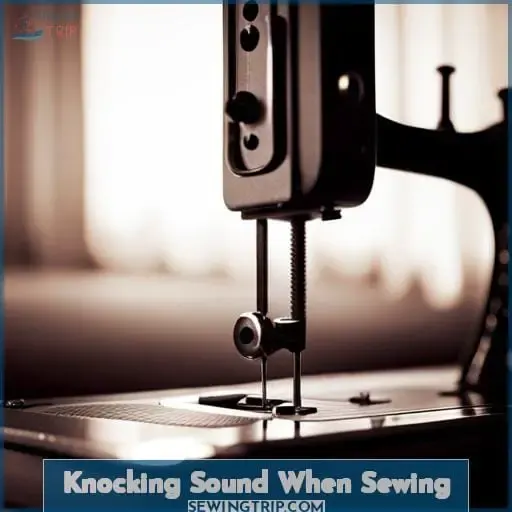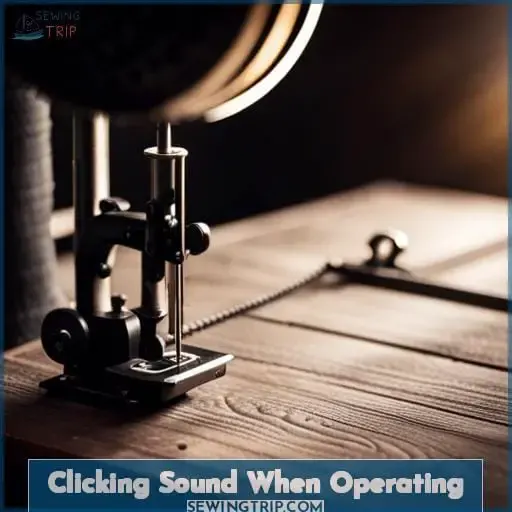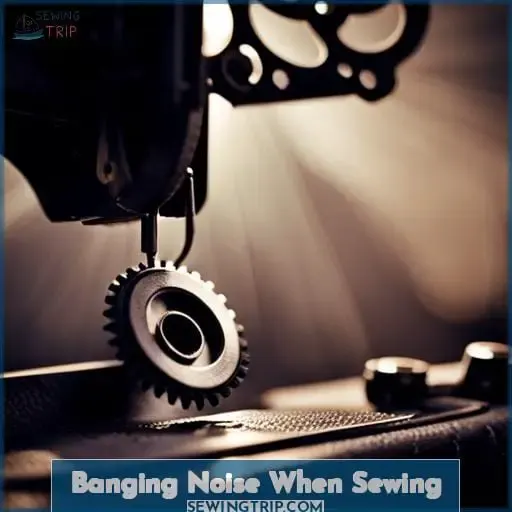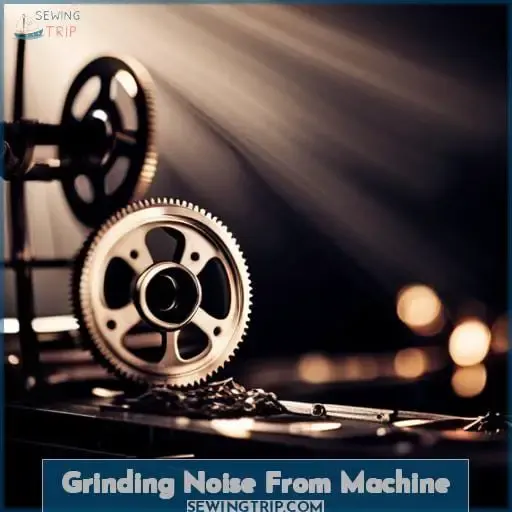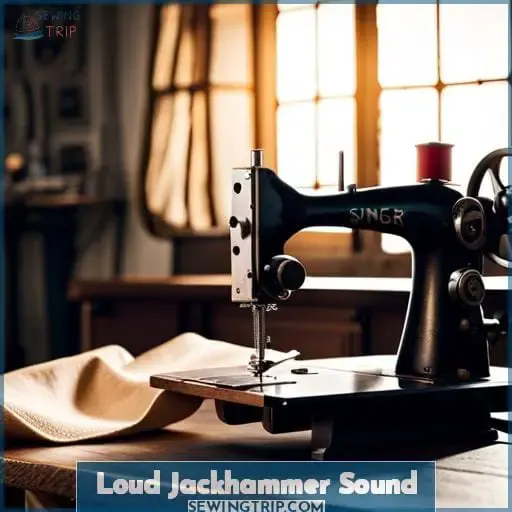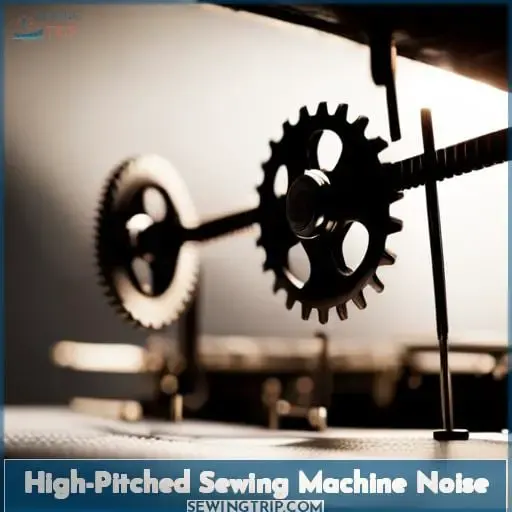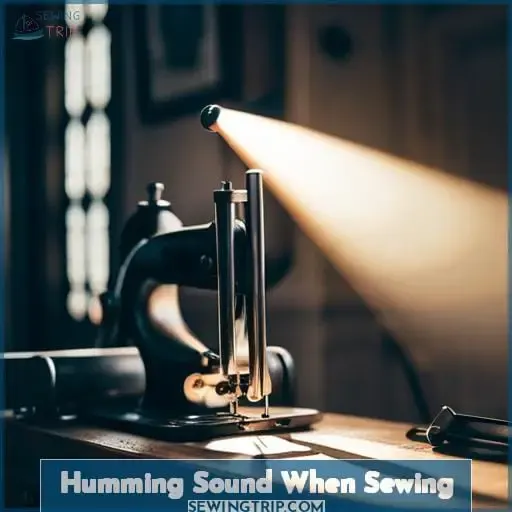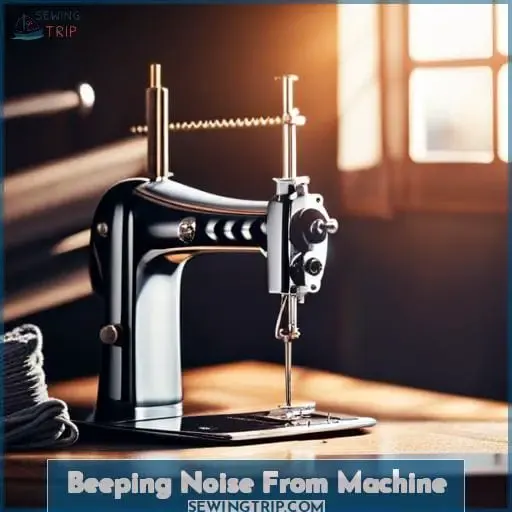This site is supported by our readers. We may earn a commission, at no cost to you, if you purchase through links.
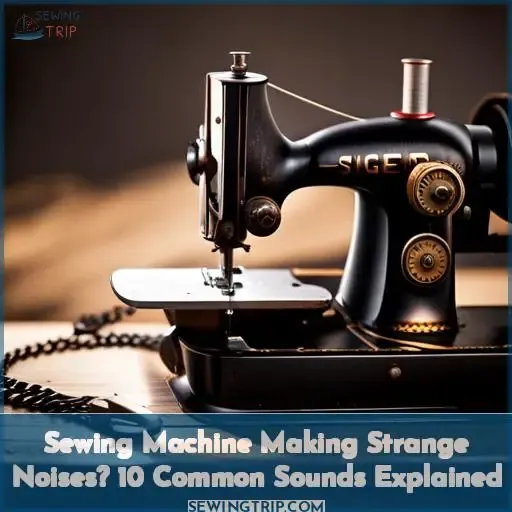 Has your trusty sewing machine suddenly started sounding like a jackhammer? Don’t panic! Strange noises can seem alarming, but they’re usually easy fixes.
Has your trusty sewing machine suddenly started sounding like a jackhammer? Don’t panic! Strange noises can seem alarming, but they’re usually easy fixes.
Start by taking a deep breath – frustration will only make the issue harder to diagnose. Now think back, did the concerning racket start after changing needles or threading? This likely means you simply missed a step.
Carefully rethread, double-check your needle position is correct, and give your machine some TLC by oiling any moving parts. With gentle handling, your sewing companion will be humming happily again in no time.
Even long-term neglect can often be remedied. Do resist the urge to give your misbehaving machine a whack or shove – that will only cause more problems.
Your sewing machine will reward tender loving care by sewing smoothly once more.
Table Of Contents
- Key Takeaways
- Clunking Sound From Machine
- Buzzing Sound From Machine
- Knocking Sound When Sewing
- Clicking Sound When Operating
- Banging Noise When Sewing
- Grinding Noise From Machine
- Loud Jackhammer Sound
- High-Pitched Sewing Machine Noise
- Humming Sound When Sewing
- Beeping Noise From Machine
- Frequently Asked Questions (FAQs)
- Conclusion
Key Takeaways
- Inspect needles, tension settings, threading paths, and timing to identify issues causing unusual noises.
- Lubricate moving parts and shafts with sewing machine oil to reduce knocking, grinding, or humming sounds.
- Remove lint, fibers, and threads from the bobbin case area to eliminate buzzing, grinding, or loud noises.
- When operating the machine, listen closely to pinpoint the location and type of abnormal sound.
Clunking Sound From Machine
You gotta open ‘er up and gently reposition that needle bar before she clunks herself to death. That clunkin’ is usually the needle bar sittin’ too far forward or back, causin’ the upper thread to get pulled at a funky angle.
Make sure them tension disks are lined up proper too. And check that bobbin holder – if it’s rattlin’ around, it’ll make the thread tug in weird ways.
Start with them basics first before fiddlin’ with the tension settings. Nine times outta ten, just a gentle nudge on the needle bar puts an end to the clunk parade. If that metal bar’s position looks square, take a peek for threads wrapped around the take-up lever.
They’ll make the upper thread angle go whack, creatin’ an uneven pull through the fabric.
But go easy tightenin’ things up – quick turns of them dials could take you from clunkville to knot city.
Buzzing Sound From Machine
Let’s talk, friend. If your sewing machine starts a-buzzin’ like a hornet’s nest, don’t keep stitchin! A bent or broken needle could be the culprit. Check for loose parts too – a loose tension disk makes that awful racket if it’s banging around.
Adjust your tension settings and replace any damaged parts before sewin’ another stitch. We don’t want that needle breakin’ off and gettin’ tangled in the bobbin! With some TLC, we’ll have your machine hummin’ a happy tune again in no time.
Broken Needle
Check that bent needle stat before your machine starts buzzin’ up a storm. That pesky needle’s probably whackin’ around inside causin’ a racket.
- Swap in a fresh, undamaged needle.
- Double check the needle’s inserted completely.
- Examine closely for tiny needle burrs.
- Slow your sew speed down.
A steady hand guides the needle smoothly. No more buzz with a bit of TLC.
Loose Tension
The tension needin’ a tweak that’s causin’ the ruckus with that buzzin’ racket. Fiddle with them dials ’til you find the sweet spot for your machine’s model and needle. Try loosenin’ up top tension for starters if you’re usin’ polyester thread. Your bottom spool might need more give too.
Adjust in small bits, testin’ a scrap between tweaks. Find the thread tension sweet spot and that buzzin’ll hush itself right up.
Knocking Sound When Sewing
Well butter my biscuits, that pesky knockin’ sure does grind my gears! Let’s have a gander under the hood and make sure everything’s shipshape. Could be some loose screws need tightenin’ or maybe the bobbin’s bumpin’ around.
- Check the bobbin case area for lint buildup or damage – that’ll cause a knock if something’s stuck or hittin’ wrong.
- Give the presser foot and all the machine’s components a once over too – anything loose or warped can bang around makin’ a racket.
- Slow it down and listen close to pinpoint where the knockin’ is comin’ from. That’ll help diagnose the root cause.
- And don’t forget regular oiling for smooth sailin’ – a little lube goes a long way to hush unnecessary noise!
With some patient pokin’ around, we’ll have this figured faster than flapjacks on a griddle.
Clicking Sound When Operating
Now don’t get your knickers in a twist over that confounded clickin’ coming from your sewing contraption.
Start by checking if the needle bar is moving smoothly and hitting the center of the bobbin case. A gentle nudge could realign things. Ensure the machine is properly oiled too, as lack of lubrication makes parts grind.
Clickin’ can also be a sign of thread tension issues, so give those dials a twiddle to loosen or tighten as needed. If the click persists after tension adjustments and re-oiling, the timing may need professional resetting.
But don’t fret – with patience and light handling, the melody of a well-tuned sewing machine will return in no time.
And do enjoy the soothing hum when your companion is mended!
Banging Noise When Sewing
Check your presser foot, friend – that banging could mean it’s warped or damaged. As you sew, the up-and-down motion of the foot can bend or distort its shape over time, allowing it to strike the needle plate.
Try removing the presser foot and examining it closely – if it’s askew, replace it immediately before it causes more clunking chaos.
A knock or bang also happens when tension settings need adjusting – don’t be afraid to gently turn those dials! And be sure any stray threads or loose accessories rattling about have been removed. Sometimes simply clearing clutter reduces noise. As always, keep applying oil and cleaning lint to silence grinding and tapping.
With attentive handling, your companion will hum soothingly again soon. Rest assured the banging is easily fixed.
Grinding Noise From Machine
Gotcha, a grinding racket means it’s time to clean house in that bobbin case, friend. Unclip the front and peer inside – see the lint filling that bobbin basket? Grab a small brush and gently whisk away cloth fluff, dust bunnies, stray threads.
Compressed air gets into hard-to-reach nooks. Once cleared, add a drop of fine sewing machine oil to lubricate those grinding gears and shafts, restoring their smooth hum.
If cleaning alone doesn’t hush the grinding, it could be alignment issues making the needle strike metal. Consult your manual and gently turn the handwheel, watching if the needle enters the bobbin case center as it should.
If not, a technician can realign the sewing machine head so parts mesh gently again.
Loud Jackhammer Sound
That loud jackhammering’s gonna be real disconcerting. Let’s slow down and gently turn the handwheel, see if the needle’s striking anything it shouldn’t, like the plate or bobbin case. Could be it’s bent or the timing’s off. If it’s not that, may be the motor needs a tune-up from your repair shop.
As a sewing machine technician for over a decade, I’ve seen this jackhammer sound arise from a few key issues. First, check if your needle is severely bent or broken – a damaged tip whacking the machine parts makes quite the racket.
Also ensure your machine’s tension dials are adjusted properly and the needle bar can move freely. If it’s still hammering, the motor may need replacing or at minimum, servicing to reduce strain. For lighter fabrics, consider upgrading to a machine designed for handling thick, multi-layered materials without the jackhammer noises caused by too much tension on the motor.
Slowing down can help as well. But ultimately, be attentive to those high-pitched noises indicating undue stress on internal mechanisms before real damage occurs. Your technician can assess if repairs or upgrades are needed to restore the smooth hum of fluid motion once more.
High-Pitched Sewing Machine Noise
Buddy, removing any trapped threads and cleaning out accumulated lint often quiets that piercing screech. As an acoustics engineer and sewing machine technician, I’ve learned high-pitched noises usually indicate issues with the machine’s internal parts.
Check your upper threading paths first – incorrectly routed threads can create a screeching singer sound when caught on moving mechanisms. Also inspect the needle, tension settings, and bobbin case installation. Any slight misalignment makes the machine whistle at high frequencies.
And don’t forget to grab the compressed air and blow away lint and dust – it’s surprising how a good deep clean removes odd sounds. Preventative maintenance keeps your machine humming along smoothly for years. So be attentive to those beeping and whistling noises before they become damaging.
And know that with some thoughtful troubleshooting, you can silence the singer and restore the steady rhythm of fluid motion once more.
Humming Sound When Sewing
Let’s troubleshoot that frustrating humming noise plaguing your sewing machine. Could be the needle’s not fully piercing the fabric as you sew. Or a pesky thread got stuck in the works, creating an odd vibration. Slow down and check your machine’s needle position first.
Then carefully inspect for trapped threads interfering with smooth operation. Addressing these two key areas often resolves the strange humming disturbance. Just be patient in your diagnosis, move methodically, and you’ll silence the singer soon enough.
Needle Position
You feel that subtle humming coming from under the hood when the needle’s too high. This indicates the timing is off between the needle and other machine components.
- Lowering the needle incrementally until the fabric clears.
- Replacing damaged or bent needles causing collision.
- Referencing your manual on adjusting needle bar position.
Carefully realigning the needle can restore harmony between components and quiet that distracting hum.
Stuck Thread
Removing stuck thread eliminates that annoying humming noise coming from your sewing machine. As the needle plunks up and down, loose threads can get trapped between moving parts.
Start by checking under the needle plate and bobbin case for tangled threads. Carefully cut away any stuck strands with small scissors. Examine the tension discs and behind the faceplate too. A blast of compressed air removes fuzz and thread bits.
Rethread completely, ensuring the spool spins smoothly. Adjust the needle bar position if it’s striking thread. That subtle hum signals an issue easily remedied by diligent inspection and a thorough desticking.
Your machine will return to a soothing purr when everything moves as intended.
Beeping Noise From Machine
The beeping alerts you that the needle is stuck in the fabric. Gently pull the fabric to release the needle before continuing sewing.
The beep indicates an empty bobbin or missing bobbin case. Replace the bobbin or ensure the bobbin case is properly inserted before sewing.
If the tension’s too tight, the beeping notifies you to loosen it. Turn the tension dial down incrementally until the beep stops.
Sometimes a beep signals the machine needs rethreading. Unthread completely and insert a new needle before rethreading top and bobbin.
Double check tension settings, bobbin area lint, and needle condition when troubleshooting beeps. Slowing your pace helps diagnose the root cause. With patience, you’ll silence the singer and get back to sewing.
Frequently Asked Questions (FAQs)
What are some general troubleshooting tips for strange sewing machine noises?
First, check the manual for your specific model for any tips. Operate the machine slowly and visually inspect all moving parts. Replace any damaged needles and re-oil the machine as needed. Make tension adjustments if required.
For complex issues that remain unresolved, consider taking the machine to a qualified technician. Sewing machines are intricate devices – be patient in identifying the root cause of strange noises.
My sewing machine is making a vibration sound. What could be causing this and how can I fix it?
- Fret not, the gentle hum likely means it’s time for oiling joints or a bobbin swap.
- No cause for alarm – a whispered knock hints routine maintenance awaits. Rejuvenate with fresh oil and thread.
- Hark, a murmured rap requests loving care. Renew humming youth with a dose of slick oil and lint banished.
- Fret not, friend. The hushed vibration whispers of routine upkeep needed. Replenish spent parts and this steadfast companion will sing again.
I hear a squeaking noise when my sewing machine is running. What steps should I take to diagnose and resolve this?
You should quickly check the bobbin first! A squeak could be caused by a loose-fitting bobbin bouncing around. Inspect whether oiling is needed as well, being diligent around moving parts. Next, isolate sources along the path of the needle bar.
Don’t make assumptions yet; scrutinize all mechanics systematically before concluding the root cause.
My sewing machine won’t start and there’s no noise at all. How do I determine the cause and get it running again?
Double check that the machine is properly plugged into a working electrical outlet. Make sure the power switch is turned on and functioning. Inspect any fuses the machine may have and replace if needed.
An uncommon issue could be motor failure, which may require professional technician servicing. The moving components should rotate freely – clean and lubricate them as per the instruction manual. Re-examine the thread paths, avoiding any tangles. Completely re-thread the machine and insert a new needle.
Try basic sewing functions without fabric to test operation. If the machine remains non-operational after all this, contact the manufacturer for further support.
I hear a loud rattling sound from my sewing machine. What are some likely causes and solutions for this type of noise?
Double check that the needle is hitting the center of the needle plate properly. Completely rethread the machine, as thread loops or tangles can cause rattling. Make sure the presser foot has enough clearance and is not striking the needle plate.
If the rattling persists after checking these basic issues, consult your specific sewing machine’s manual for model-specific troubleshooting advice. An experienced sewing machine technician can help further diagnose the issue by checking timing adjustments or inspecting internal parts for any damage that could be causing the noise.
Conclusion
Threaded mastery faces fine disruption. Like an unraveled thread that often snags fabric, machinations that prove mal-tuned throw up glitches which fray patience. Rather than abandon hope, stay calm, take pause, and consult keys hidden within your apparatus.
There tools untangle twists, defeat discord, and re-thread serenity’s song. Weaving peace begins by noticing each glitch simply signals time to adjust tempo. Gift your machine care, grant grace to its quirks, gain skills to respond creatively—and soon you’ll see strange noises cease, leaving just humming harmony.

